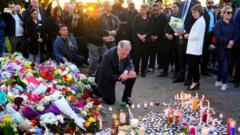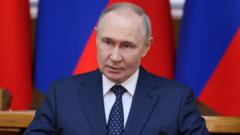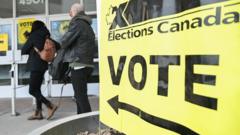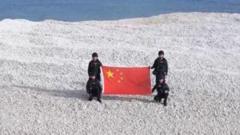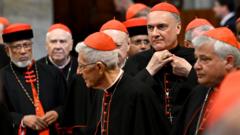**With both parties having new leadership, the stakes are higher as voters weigh economic strategies and responses to external pressures.**
**Canada Elects New Leader Amid Political Turmoil and U.S. Pressure**

**Canada Elects New Leader Amid Political Turmoil and U.S. Pressure**
**Citizens are voting today in an election that will shape Canada's future amidst President Trump's threats and geopolitical uncertainty.**
Canadians find themselves at the polls today for a critical election, one that promises to redefine the leadership of their nation amidst rising tensions and tumultuous economic conditions influenced by U.S. politics. After months of campaigning, voters will decide between the Liberal Party led by newcomer Prime Minister Mark Carney and the Conservative Party headed by veteran politician Pierre Poilievre.
Recent polls have shown a shifting political landscape, with the Liberal Party gaining traction following the resignation of former Prime Minister Justin Trudeau amid frustrations over his governance. As Trump’s ongoing trade war poses direct threats to Canada’s economy, both parties aim to present their approaches to restoring stability and fiscal growth.
The election has drawn the attention of five additional parties, including the New Democrats and the Bloc Québécois, who fight for seats in Parliament, although they are not expected to play a decisive role in the leadership battle between Carney and Poilievre. The impact of U.S. tariffs, particularly those hitting automotive tariffs, looms large in voter minds, amplifying concerns about economic resilience.
Carney, a former central banker with a robust international background, offers a platform that emphasizes his expertise in financial management. He aims to position the Liberals as the safer choice for navigating the complex dynamics introduced by Trump’s aggressive policies. His experience in global finance is seen as an asset, especially amidst fears of economic instability.
Conversely, Poilievre seeks to capitalize on his long-standing status as a Conservative fixture, promoting policies aimed at deregulation, reduced government size, and an aggressive approach to U.S. trade. His connection to Trump’s populist style has been a double-edged sword; while it resonates with certain voter blocs, it has also alienated moderates who view Trump’s rhetoric as damaging.
Voters are framing today’s ballot as a referendum on who can best defend Canada’s sovereignty and protect the economy from external threats. Polls opened across Canada at staggered times and are projected to close at 9:30 p.m. Eastern Time. Canadians have also been encouraged to exercise their right to vote early—approximately 7 million participated in the advance voting—the highest in recent memory.
As ballots are cast, the political climate remains charged with uncertainty. In addition to economic viability, the leadership chosen today will have to manage a complex relationship with a U.S. administration that poses both opportunities and substantial risks. Results are expected late into the evening, and with both major parties vying for a narrow edge, all eyes remain on a collective choice that will undoubtedly shape Canada’s political landscape for years to come.
Recent polls have shown a shifting political landscape, with the Liberal Party gaining traction following the resignation of former Prime Minister Justin Trudeau amid frustrations over his governance. As Trump’s ongoing trade war poses direct threats to Canada’s economy, both parties aim to present their approaches to restoring stability and fiscal growth.
The election has drawn the attention of five additional parties, including the New Democrats and the Bloc Québécois, who fight for seats in Parliament, although they are not expected to play a decisive role in the leadership battle between Carney and Poilievre. The impact of U.S. tariffs, particularly those hitting automotive tariffs, looms large in voter minds, amplifying concerns about economic resilience.
Carney, a former central banker with a robust international background, offers a platform that emphasizes his expertise in financial management. He aims to position the Liberals as the safer choice for navigating the complex dynamics introduced by Trump’s aggressive policies. His experience in global finance is seen as an asset, especially amidst fears of economic instability.
Conversely, Poilievre seeks to capitalize on his long-standing status as a Conservative fixture, promoting policies aimed at deregulation, reduced government size, and an aggressive approach to U.S. trade. His connection to Trump’s populist style has been a double-edged sword; while it resonates with certain voter blocs, it has also alienated moderates who view Trump’s rhetoric as damaging.
Voters are framing today’s ballot as a referendum on who can best defend Canada’s sovereignty and protect the economy from external threats. Polls opened across Canada at staggered times and are projected to close at 9:30 p.m. Eastern Time. Canadians have also been encouraged to exercise their right to vote early—approximately 7 million participated in the advance voting—the highest in recent memory.
As ballots are cast, the political climate remains charged with uncertainty. In addition to economic viability, the leadership chosen today will have to manage a complex relationship with a U.S. administration that poses both opportunities and substantial risks. Results are expected late into the evening, and with both major parties vying for a narrow edge, all eyes remain on a collective choice that will undoubtedly shape Canada’s political landscape for years to come.




